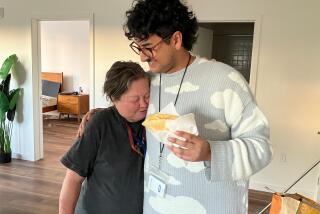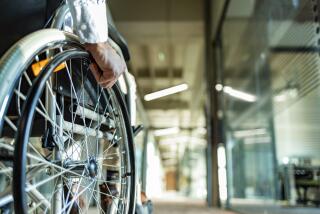Freedom Fighter : Paralyzed Therapist Teaches Patients How to Be Independent
- Share via
All Jamie Danskin wants is for her patients to stand on their own two feet.
Just as she does.
And that’s the lesson she is teaching this day as she clamps a couple pounds of weights on Jeff Wassenaar’s left arm and orders him to start pumping.
Wassenaar is in a tiny workout room on the second floor of Daniel Freeman Memorial Hospital in Inglewood. His legs paralyzed, he is sitting in a wheelchair.
Just as Danskin is.
“When she says you can do it, she means it,” says Wassenaar, a 22-year-old traffic light installer from Bellflower. “When she says you can do it, she knows it.”
Danskin, 21, is an assistant occupational therapist at the hospital’s spinal cord injury center. Paralyzed herself at age 14 by a car crash, she also knows the importance of independence.
That’s why she sometimes works almost 60 hours a week helping teach spinal injury patients how to dress themselves, wash their clothes, cook dinner and a hundred other things they have to relearn.
When Danskin explains something, they believe her. After all, she’s been there.
“She gives me a positive attitude,” said Wassenaar, who was paralyzed Oct. 14 in Downey when a carjacker shot him five times. “Like getting clothes from the top of the closet--when you say you can’t, she shows you that you can.”
Some patients cry. Others make her want to cry. But Danskin says she got that emotion out of the way early in her own paralysis.
Her experience after a 1987 auto accident prompted her to earn an associate’s degree in occupational therapy from Mt. St. Mary’s College in Los Angeles and then seek the hospital job.
*
She was riding with an 18-year-old friend to Wednesday night church services outside her tiny hometown of Lawson, Mo., when his car missed a curve and went into an embankment. Danskin’s back was broken when she was thrown into the back seat.
Like many spinal cord injury victims, Danskin believed that she would walk out of the hospital--even after a doctor informed her parents: “Read my lips: She’ll never walk again.”
Months of rehabilitative therapy followed. But in the back of her mind, Danskin believed that her injuries would somehow heal. And the by-the-book therapy she received from a somewhat detached therapist didn’t help.
“I thought it would pass, that I’d walk again,” she said. “I had an occupational therapist coming in to help me bathe and dress. But she didn’t tell me what she was doing or why it had to be done. I’d ask what I had to do to get it over with and she’d say I had to put on stockings or something. It was frustrating.”
Her tiny high school built a new bathroom to fit her wheelchair and Danskin eventually returned to graduate. She enrolled at the University of Illinois and quickly became involved in wheelchair sports. Eventually, she qualified for the U.S. basketball team at the Pan American Games.
It was at a 1990 tournament in Venezuela that she met Ed Danskin, a friend of her coach. They married two years later and settled in Gardena after he got a job as a school behavioral specialist.
These days, she plays wheelchair hockey for fun, is a championship tennis player, helps coach basketball at Widney High School in Los Angeles and can go anywhere--except sandy beaches--by herself. Last week, she chauffeured her visiting parents, Pat and Dave Robison, to sightseeing spots around town in her specially equipped Blazer.
She was hired at Daniel Freeman in August after briefly working there as an occupational therapy trainee through Mt. St. Mary’s.
Some patients are wary when they see Danskin roll up. “They’re afraid I can’t do the same things an able-bodied therapist can do,” she said.
They change their minds when they see her demonstrate what she wants them to do--when they see her pull herself in and out of her chair and reach for things on high shelves without asking for help.
“I explain to patients why I’m asking them to do things,” Danskin said. “I tell them that stretching increases muscle strength in their arms--and that their arms are their transportation.
“Some patients want to be babied. I try not to do that, because that isn’t going to help them. Some don’t try hard because they feel they’re going to walk again. I understand what they’re going through.”
Medical experts say the approach used by Danskin is a plus for the 10,000 people who suffer paralyzing spinal cord injuries in the United States each year.
“It means a lot coming from somebody who has actually surmounted these challenges,” said Susan Howley, director of research for the American Paralysis Assn. in Springfield, N.J.
In addition to learning more quickly to cope with their disabilities, patients who work at staying strong could find themselves the best candidates to take part in new therapies that may someday be developed to mend spinal injuries, she said.
Except for a handful of paraplegic occupational therapists in Denver and Atlanta, few others work in the United States, said Janna Jacobs, executive director of the National Spinal Cord Injury Assn. in Cambridge, Mass.
“A decade ago, if she decided to go to OT school they’d have laughed at her,” Jacobs said. “But do patients react well to a therapist in a wheelchair? You bet.”
Dr. Carl Orfuss, a neurologist who runs the Daniel Freeman spinal cord rehabilitation program, said he encouraged Danskin to “stick around” after he observed her effect on patients during her student internship.
“She can do anything. Patients see her attitude, the ease she can do things. They see her doing all the things we’re teaching,” Orfuss said.
Danskin has worked with about 40 patients so far. They are split about evenly between car crash and gunshot victims. Many send her candy and cards to thank her when they leave the hospital.
*
Back in the exercise room, Wassenaar motions to Danskin with a single thumb up, his left. He can’t move his right hand yet because of bullet wounds to his right arm. The day after he was left for dead in the street by an attacker who was never caught, his Buick was recovered by police, totally stripped.
No matter, suggested Wassenaar.
“I’ll be in a little chair like that pretty soon,” said the father of three, pointing to Danskin’s sports-style set of wheels.
“Then I’ll be able to really get around.”
More to Read
Sign up for Essential California
The most important California stories and recommendations in your inbox every morning.
You may occasionally receive promotional content from the Los Angeles Times.














